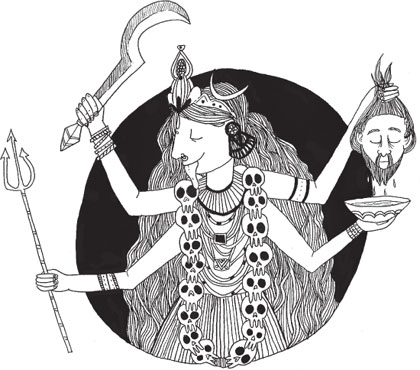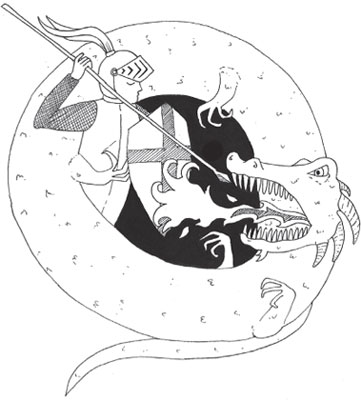The Little Book of the End of the World (11 page)
Read The Little Book of the End of the World Online
Authors: Ken Mooney


9
THE HOME OF THE APOCALYPSE: POLITICS OF THE MIDDLE EAST
Most of the religions and beliefs we have looked at so far have their origins in in the Mediterranean and Middle East. With so many faiths blossoming in the region, it should come as no surprise that politics have gotten involved.
Many of the locations that are holy or sacred to one faith are shared by others, and the possession of these landmarks has become a bone of contention. Some of these issues have focused on the potential dangers of the End of the World, others have threatened to bring that moment ever closer.
THE CRUSADES
One of the bloodiest periods of human history, the Crusades, began in the eleventh century
AD
and were a series of incursions into the Middle East from Europe. There are many reasons behind the Crusades, some political, some religious and some motivated entirely by wealth. By the time of the Crusades, most of central Europe was united under the Holy Roman Empire, a sort of precursor to the European Union. As the name suggests, the Holy Roman Empire was defined by its shared religion, and this religion affected how it reacted with other nations, leading to increased hostility with the neighbouring – and mostly Muslim – Byzantine Empire.
The Crusades arose from a European need to see Jerusalem freed from the oppression and ownership of the Byzantine Empire, assuring access for Christian pilgrims. The Crusades may also have been, simply, an ideological war between Christianity and the growing faith of Islam.
The Crusades lasted for nearly 200 years, with different countries leading the charge under different leaders and regimes: it’s safe to say that over that period, motivations shifted significantly, with different causes coming to the fore at any given time.
There were nine Crusades undertaken by the Holy Roman Empire between 1095 and 1272, but not all of these involved every major state. There were also several other incursions undertaken by individual countries or noblemen, with even more were organised by faithful laypeople who were not affiliated with government, Church or monarchy.
The Crusades provide a small taster of the atrocities and difficulties in any holy war, and perhaps a snapshot of what could happen during the End of Days.
The People’s Crusade of 1096 is notable because of the involvement of many laypeople and pilgrims from throughout Europe. The numbers involved make this one of the largest disasters and losses of life during the Crusades, with Crusaders responsible for the deaths of thousands of Jews across Europe and, in turn, many of these Crusaders slaughtered by the more experienced Turkish soldiers.
What is notable about the People’s Crusade is the anger and violence directed towards Jewish communities in Europe. As calls for Crusaders spread around Europe, the faithful directed their persecution towards the Jewish communities around the Rhineland in Germany. This violence led to the destruction of whole cities which had become Jewish settlements, and was, unfortunately, not the first time that this type of violence had been directed at the Jewish people.
Despite the numbers of Jews killed in their own homes and communities, there are many stories throughout Europe that try to elicit sympathy for the Crusaders themselves; even as they pillaged and invaded other countries, the Crusaders were portrayed as righteous and doing God’s bidding. Perhaps the most interesting of these stories is the Children’s Crusade, a Crusade that may not have even existed.
The stories of the Children’s Crusade revolve around a group of faithful children who took it upon themselves to travel to the Holy Land, and the story is made all the more brutal by suggesting that most of these children fell to slavery, famine and the swords of the Byzantine Empire. The Children’s Crusade supposedly began when a child prophet professed to receiving a message from Jesus and subsequently convinced his followers to travel with him to Jerusalem. The child even claimed that the Mediterranean Sea would part before them, meaning they did not need passage across the water.
In actual fact, this version of the Children’s Crusade appears to be a combination of two separate stories:
![]() Stephan of Cloyes was a French shepherd boy who gathered a group of followers and claimed to have received a message from Jesus to be delivered to Philip II, the King of France. Stephan’s pilgrimage to the king gradually gathered him followers, most of whom were vagabonds and beggars. However, the king refused an audience with Stephan and his followers quickly dispersed.
Stephan of Cloyes was a French shepherd boy who gathered a group of followers and claimed to have received a message from Jesus to be delivered to Philip II, the King of France. Stephan’s pilgrimage to the king gradually gathered him followers, most of whom were vagabonds and beggars. However, the king refused an audience with Stephan and his followers quickly dispersed.
![]() Nicholas of Cologne tried to encourage a Children’s Crusade but never actually left the European mainland. Travelling from Germany, Nicholas gathered an impressive bunch of followers, many of whom passed away while they crossed the Alps. When they reached the Mediterranean, they found that the seas did not part before them as Nicholas had promised. Disappointed, most of them returned home, with some of the pilgrims settling locally in Genoa. Nicholas himself decided to return home but passed away en route. Meanwhile, back in Cologne, Nicholas’ family were killed by neighbours whose children had followed him and subsequently been lost.
Nicholas of Cologne tried to encourage a Children’s Crusade but never actually left the European mainland. Travelling from Germany, Nicholas gathered an impressive bunch of followers, many of whom passed away while they crossed the Alps. When they reached the Mediterranean, they found that the seas did not part before them as Nicholas had promised. Disappointed, most of them returned home, with some of the pilgrims settling locally in Genoa. Nicholas himself decided to return home but passed away en route. Meanwhile, back in Cologne, Nicholas’ family were killed by neighbours whose children had followed him and subsequently been lost.
Despite the continued failures of the Crusades, the attempts to ‘win back’ the Holy Land continued into the fifteenth century and the Middle East continues to have political problems to the present day.
ST GEORGE AND THE DRAGON
One of the small benefits of the Crusades was an influx of Eastern goods and traditions back to the Holy Roman Empire and beyond, with those Crusaders who had survived bringing with them legends and stories from the Middle East.
One such story has had a lasting effect on the United Kingdom: St George and the Dragon. But even though St George has become the patron saint of Britain, his name borne by multiple kings and heirs, George’s story does not come from Britain.
St George, or Georgius, was born in third-century Palestine and was a soldier in the Roman army at a time when Christians were still subject to persecution and death. Georgius was a respected soldier, and when the Emperor Diocletian ordered the death of every Christian in the Roman army, he was offered his life if he renounced his faith. When Georgius was subsequently sentenced to death, he donated all of his possessions and wealth to the poor.
Initially, Diocletian’s plan was to kill off Christian influences within the military and elsewhere in the empire; instead, Georgius became a martyr, with his actions encouraging other Christians to profess their faith, and many other Roman citizens converting to Christianity to follow his example.

However, George’s most lasting legacy is an adventure that may prove to be entirely fictional, in which Georgius comes face-to-face with a dragon-like beast that allows him to reaffirm his faith. The dragon that George faces is not as monstrous as some of the beasts of Revelations, but its role here cannot be ignored. The dragon is linked to a city of non-Christians and is ultimately defeated when the city converts to Christianity.
The city in question is Silene, a location that has long been lost, or perhaps known under another name – given the facts of Georgius’ life and military service, Silene is likely to have been in northern Africa, potentially Libya.
Silene’s dragon problem was not quite a dramatic
The Hobbit
-style affair: the dragon had simply set up beside the local lake, blocking the city’s access to fresh water. In order to distract the dragon and retrieve water from the lake, the inhabitants of Silene would sacrifice a sheep to the dragon, fetching their water while the dragon ate.
When the people of Silene finally ran out of sheep, they turned to sacrificing maidens.
The story goes that George arrived in Silene just before the local princess was about to be sacrificed as the most recent distraction. George came to her rescue, wounding the dragon and leading it back towards the city. As the dragon moved closer, the citizens of Silene were obviously concerned, but George promised them that he would slay the dragon – if they converted to Christianity.
George’s story appealed to the sensibilities of the Crusaders and the faithful at home in England: he became a hero because he bore witness to his religion, succeeded in converting an entire city to the faith and, ultimately, died for his beliefs.
Of course, George’s triumph over the dragon also helped to cement him as a hero who had triumphed over a beast aligned with fire, similar in many ways to Revelations’ depictions of Satan.
The gallant George and his protection of the princess’ virtue also appealed to the popular story genre of Romance, with its tales about chivalrous knights and endangered maidens. In fact, even though he was long dead at the time, George is typically portrayed with the armour and heraldry of a knight of the Middle Ages rather than a soldier of the Roman Empire.
ZIONISM AND THE ORIGINS OF MODERN ISRAEL
Much of the political focus on the Middle East stems from the importance that all Abrahamic religions place on the area. Jerusalem is a site of great significance to all three religions, with pilgrimage to the area an important part of both the Jewish and Islamic faiths.
Although the Muslim pilgrimage, or
hajj,
traditionally brings its followers to Mecca, Jerusalem is nonetheless considered the third-holiest place in Islam as the home of the Al-Aqsa Mosque which was visited by Muhammad on his journey to Heaven. Control of Jerusalem therefore grants political, religious and economic power: not only does a religion want to claim access to Jerusalem for their own faith, but a cynical reader might suggest that any claim to the city also gives access to the tourism routes that are a part of the pilgrimage process.
Jerusalem and its surrounding areas have been a hotly contested, occupied area since the time of the Bible. The area was part of the Roman Empire at the time of Jesus, falling under control of the Byzantine Empire until the sixteenth century. The Byzantine Empire was succeeded by the Ottoman Empire, and following that empire’s collapse at the close of the First World War, the area fell under control of the British Empire.
For the Jewish faith, Jerusalem and Israel are the heart of lands promised to the Jewish people from the times of the Old Testament. Successive invasions and occupations have led to thousands of years during which this promise has not come to pass, leading many Jewish writers and philosophers to describe a great spiritual longing for the area.
